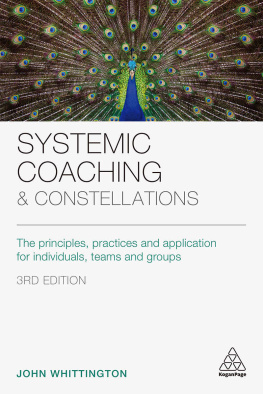Inhalt
Carl-Auer

Invisible Dynamics
Klaus P. Horn/Regine Brick
Systemic Constellations in Organisations and in Business

Cover: WSP-Design, Heidelberg
Layout: Driner-Design u. DTP, Mestetten
eBook edition, 2018
ISBN 978-3-8497-8169-9 (ePUB)
2001 Gabal Verlag GmbH, Offenbach
for the English edition 2005, 2018 by Carl-Auer-Systeme Verlag und Verlagsbuchhandlung GmbH, Heidelberg
All rights reserved. No part of this book may be reproduced by any process whatsoever without the written permission of the copyright owner.
Title of the original edition:
Das Verborgene Netzwerk der Macht
Bibliographic information published by Die Deutsche Nationalbibliothek.
Die Deutsche Nationalbibliothek lists this publication
in the Deutsche Nationalbibliografie; detailed bibliographic
data available on the Internet http://dnb.d-nb.de.
Published by Carl-Auer Verlag: www.carl-auer.com
Please order our catalogue:
Carl-Auer Verlag GmbH
Vangerowstrae 14 69115 Heidelberg
Tel. + 49 6221 6438-0 Fax + 49 6221 6438-22
Contents
3.3What do we need in order to grow together?
Problems following a German-French company merger
3.5Who is the undercover boss here?
A business consultant on the wrong track
3.6Where am I heading?
A successful professional at a fork in the road
Foreword
BY OTTO WASSERMANN
The constellation methods described in this book have been used successfully in our company for years.
As specialists in process-orientated management for over fifteen years, we have organised procedures and supply chains in business and industry using our own simulation software. Using this software, we can simulate the procedure and handling of future contracts and materials. We create a situation as though the planning, procurement and production were actually taking place.
Identify bottlenecks using simulations.
The simulation identifies potential bottlenecks so that they can be corrected before they can cause delays or missed deadlines or affect productivity. With problem areas cleared, contracted work and materials flow freely through the company and supply chains.
An ingenious idea, but so simple and unusual that it often meets with scepticism or even complete rejection. Simulation isnt the same as reality! Do you actually think you can depict our complex procedures using software? Theres no way it can work.
Communications up-date
These are some of the reactions, plus a lot of head shaking, that we are often confronted with when we approach new customers. For many years Dr. Horn and his team have helped us to deal with this reaction constructively, using systemically orientated training. Instead of retaliating with a defensive, Yes, but , on our side, we have been able to recognise the signs of interest embedded in such negative reactions. The ice is soon broken and, after a while, our customers themselves cant remember why they were previously so blind to something as easy and effective as this. In the process, they are also learning to overcome barriers and anxiety and to work together as a goal-orientated team. Our trainers call that a communications update, one that alters old patterns and habits that are no longer useful.
Nonetheless, like many of our customers, I had a similar reaction when Dr Horn told me one day that using a different kind of simulation he could depict a human business system and smooth out problem areas just as we were doing with technical business systems. I felt that it was clearly impossible, because you would have to deal with people in all their complexity. Of course, he interpreted this as a sign of interest on my part, and so it led to our people sitting down together to get acquainted with this new kind of simulation.
We presented Dr Horn with a customer situation that we felt was a complete muddle, one that had already cost us many sleepless nights, and we challenged him to demonstrate how he could put it in order.
Confusing situations made clear
Using representatives, we set up a constellation of the system, and we were truly amazed. It was crystal clear to everyone exactly what was going on. This confusing muddle was suddenly laid open like a book. Every person in our group felt as though a veil had been dropped, we could see where the problem lay and what the solution was. The real surprise, however, was still to come when, less than three months later, the exact solution that had appeared in the constellation actually emerged in reality!
Why constellations function, we still dont really understand, and neither do the systemic experts, but the fact that they do and that they lead to solutions, can be documented.
These days, to the benefit of our customers, we work successfully with Dr Horn and his partner as specialists for business systems: we at the technical level, and they at the level of human interaction.
To get the most benefit from this book, regard your own objections as signs of interest. You will be richly rewarded by valuable, stimulating input that perhaps may sometimes seem like magic.
Otto Wassermann
Chairman of the Board, Wassermann AG
Introduction
Do you understand the significance of a good team line-up in football? Do you know how important network connections are for the marketing success of a company? If you do, then you are already familiar with some of the most important principles of this book.
Well-connected
Today, a business is considered well positioned and well-connected when it is in a strong market position, with executives skilled in human resource management. Behind the rhetoric lies more than just a passing trend. It reflects the importance of the network connections within the organisation for the success or failure of the operations. Because awareness of these connections is at an unconscious level, it has been little used up to now, denying us a valuable navigational tool. The network constellations, in which our business ventures are embedded, are by no means accidental. These interpersonal systems, which we know as teams, departments, companies, and markets, follow certain laws, and their success depends on the degree to which they conform to these laws.
The systemic constellation method offers a tool that can depict complex interconnections and reciprocal effects in a clear and simple way. In widespread networks as well as clearly defined teams, this method also helps to sort out entanglements and to recognise hidden resources in obstacles.
More inner democracy
As in any new development however, this method also presents you with an unreasonable demand. What is it? It demands that you risk more inner democracy. To profit from this method, you have to dethrone your rational mind as the sovereign ruler in ways of learning, problem solving and innovation. Relinquishing this out-dated monopoly on the transfer of information and energy makes much in the business world more attractive and colourful. Letting go of the monopoly of a linear-analytic method also opens new pathways in business management and consulting. It complements the potential of logical thinking and digital analysis with the invisible knowledge and concealed information already existing in the organisations system.











